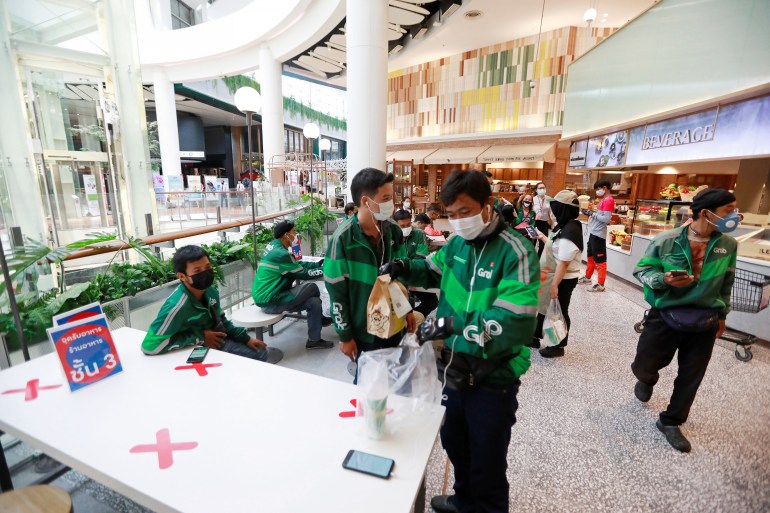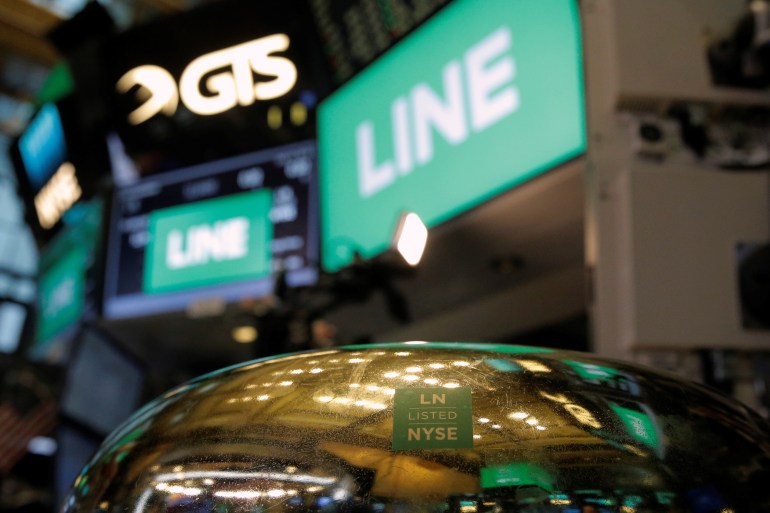Thailand’s food delivery drivers feel pinch as Grab, Line rack up losses | Technology

[ad_1]
Bangkok, Thailand – When Piti began working as a Grab delivery driver at the height of the COVID-19 pandemic, the 26-year-old Bangkok resident had little trouble earning a decent wage.
But after two years of delivering food to homes and offices, Piti’s earnings have taken such a dramatic hit that he is looking to switch jobs.
For the past few months, Piti says he has been receiving a starting rate of 38 baht ($1.07) per food order, down from 40 baht ($1.12) in the past.
Worse still, Piti says he picks up far fewer gigs due to a sharp rise in the number of drivers on the road.
“I used to earn about 2,000 baht [$57] per day, but now some days I earn just 900 baht [$25],” Piti, who asked to use a pseudonym to avoid retaliation, told Al Jazeera.
Piti plans to switch to transporting passengers with Grab’s ride-hailing service, which he says pays a more attractive rate of 35 baht ($0.98) per kilometre.
In Thailand, one of Southeast Asia’s most competitive markets for “super apps” like Grab, food delivery drivers are seeing their earnings fall as platforms cut costs amid tough business conditions.
Grab Holdings, which controlled about 44 percent of the Thai market as of 2021, went public in New York in 2021 following a blockbuster $39.6bn merger with a blank cheque company.
But despite ranking as Southeast Asia’s most valuable tech unicorn, the Singapore-based start-up has struggled to rein in its losses and has yet to turn a profit.
In June, Grab cut more than 1,000 jobs, the biggest round of layoffs since 2020, when the firm cut 360 jobs.
CEO Anthony Tan described the cuts as a “painful but necessary step” to remain competitive in the future.

Other food delivery platforms have faced similar difficulties.
Line Man, a Japanese-owned delivery app, reported a loss of 2.7 billion baht ($75.9m) last year, down 14 percent from 2021, despite growing revenue 88 percent to 7.8 billion baht ($219m), according to analytics firm Creden Data.
The Kasikorn Research Center, a think tank in Bangkok, has estimated that the market value of the food delivery business in Thailand will shrink this year by 11.3 percent compared with 2022 as the volume of food orders declines post-pandemic.
Food delivery drivers for a number of different platforms that spoke to Al Jazeera said that they had been offered no explanation for their rates being cut.
Pon, a driver for several platforms including Robinhood, said his basic pay per order had been reduced from 43 baht ($1.21) to 39 baht ($1.10).
“I have spoken to friends on many platforms, and we have faced the same situation,” Pon, who asked not to be referred to by his real name, told Al Jazeera.
Like many drivers, Pon rotates between apps, sometimes even switching platforms on the same day.
Platforms such as Grab, Foodpanda, Robinhood and Line Man Wongnai all share similar pay structures: Drivers are paid per delivery order and receive higher for longer distances.
In some cases, incentives are offered to encourage drivers to meet the revenue targets.
With no set salary, the more hours a driver works, the higher the pay.
“Rates are high during 11am-2pm and 5pm-7pm and especially when it’s raining because that’s when orders are at their highest,” Natee, a 39-year-old Foodpanda driver who asked to use a pseudonym, told Al Jazeera.
Like other drivers, Natee, who quit his factory job after his boss failed to pay him overtime, has seen his rates on Foodpanda decline.
He supplements his income by transporting passengers on Bolt, a ride-hailing app that launched in Thailand in 2020.
“Many drivers have diversified their income streams by simultaneously working for multiple ride-hailing platforms,” Hilman Palaon, a digital economy expert at the Australia-based Lowy Institute’s Indo-Pacific Development Centre, told Al Jazeera.
“This multifaceted engagement allows them to switch between platforms based on the prevailing demand and pricing conditions.”
James Guild, an adjunct fellow at S Rajaratnam School of International Studies (RSIS) in Singapore, said it was not surprising that platforms would give drivers a lower split of revenues than in the early days.
“Now their priority is profitability, so we should expect drivers, merchants and consumers to see less generous incentive schemes and revenue splits and higher fees,” Guild told Al Jazeera.
“Grab needs to make some adjustments somewhere in its business model, because it has been fantastically unprofitable. The question is where and who will bear the costs of these adjustments.”

Line Man Wongnai, which launched in 2020 as a delivery arm of Thailand’s popular messaging app Line, said drivers’ rates normally fluctuate due to the user demands in each area, the local economy, the level of competition, and the weather.
“Our latest adjustment in March did both rise and drop in different areas,” Isriya Paireepairit, Line Man Wongnai’s vice president of public affairs, told Al Jazeera.
“In the central Bangkok area, where the demand is very high, we raised the compensation.”
Grab Thailand declined to comment on the pay cut.
In June, Worachat Luxkanalode, managing director at Grab Thailand, said that the platform enjoyed growth after the country reopened following the pandemic.
He said food delivery orders had stayed strong, supported in part by remote working, but the platform was working on increasing value per order by partnering with more restaurants and introducing more promotions for users.
Luxkanalode admitted that the food delivery service was not a profitable business model.
“[For example], with every order of 100 baht [$2.81], Grab receives 20 baht [$0.56] commission from the restaurant and pays the driver 40 baht, which means we instantly lose 20 baht,” he said.
Facing profitability issues, platforms have been seeking to diversify their revenue streams.
Line Man Wongnai is aiming to capitalise on the 50 million strong users of Line through integration with services like Line Chat, Line Pay and Line Shopping.
Grab’s Luxkanalode said at an event in July last year that the platform planned to offer more financial services, including low-interest rate loans for its drivers and food vendors.
Grab Thailand already offers hotel booking, digital wallet services and customised delivery services for laundry or groceries, for example.
“We are entering an interesting transition period, though, as they pivot from growth toward profits,” RSIS’ Guild said.
“Turns out it is hard to make money in ride-hailing and delivery, so these apps are now looking to leverage their big customer bases into financial services customers, which is generally a more profitable line of business.”
Guild said the future of the gig economy was unpredictable after its promising start.
“It definitely has had positive impacts by reducing transaction costs and matching buyers and sellers more efficiently,” he said.
“It has helped small businesses enter markets that used to be closed to them. A few years ago, drivers who put in the hours were making well above minimum wage in Indonesia. Back then they were receiving very attractive incentives because the goal was to on-board more drivers. Those days seem to be behind us.”
[ad_2]



